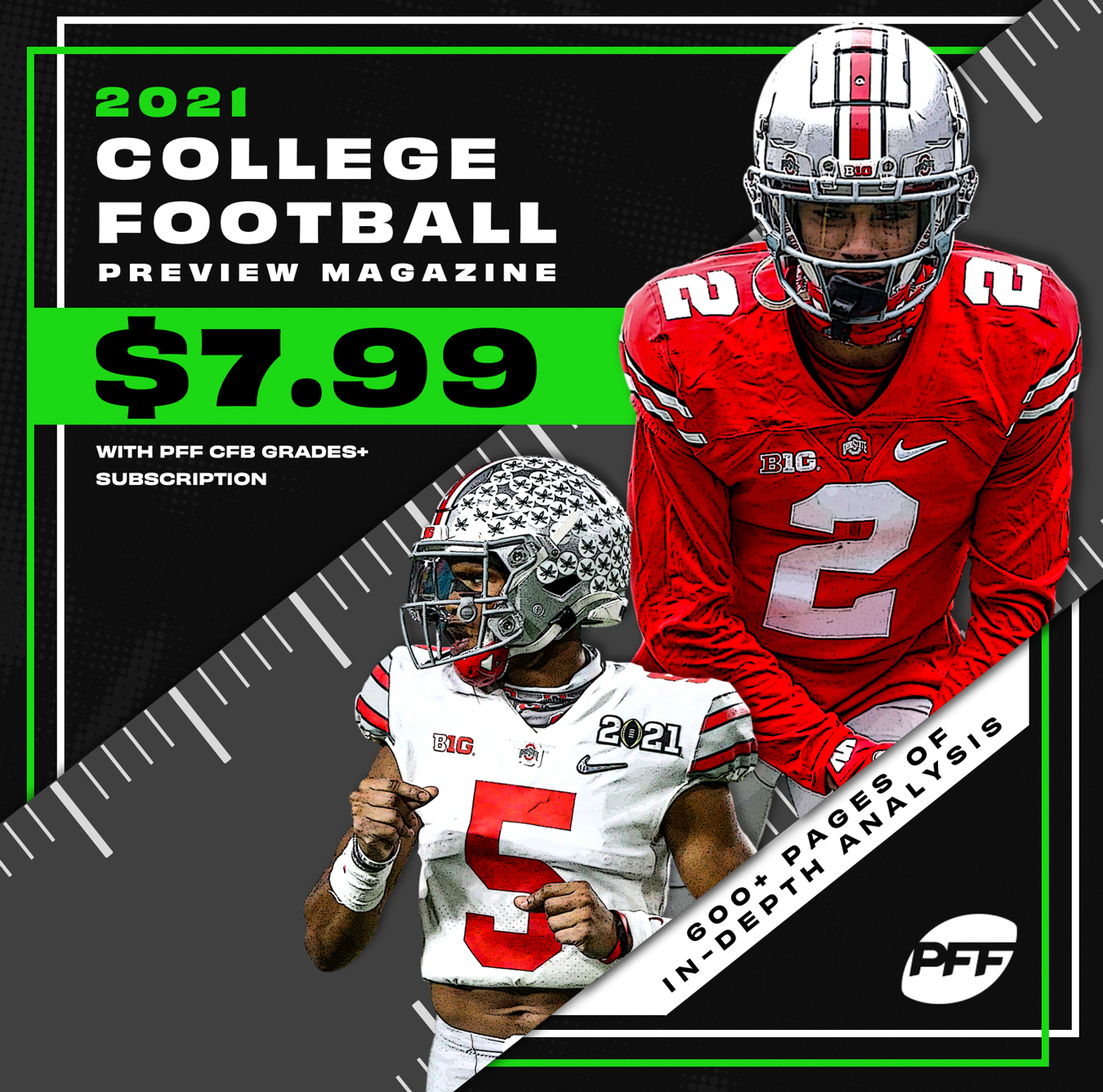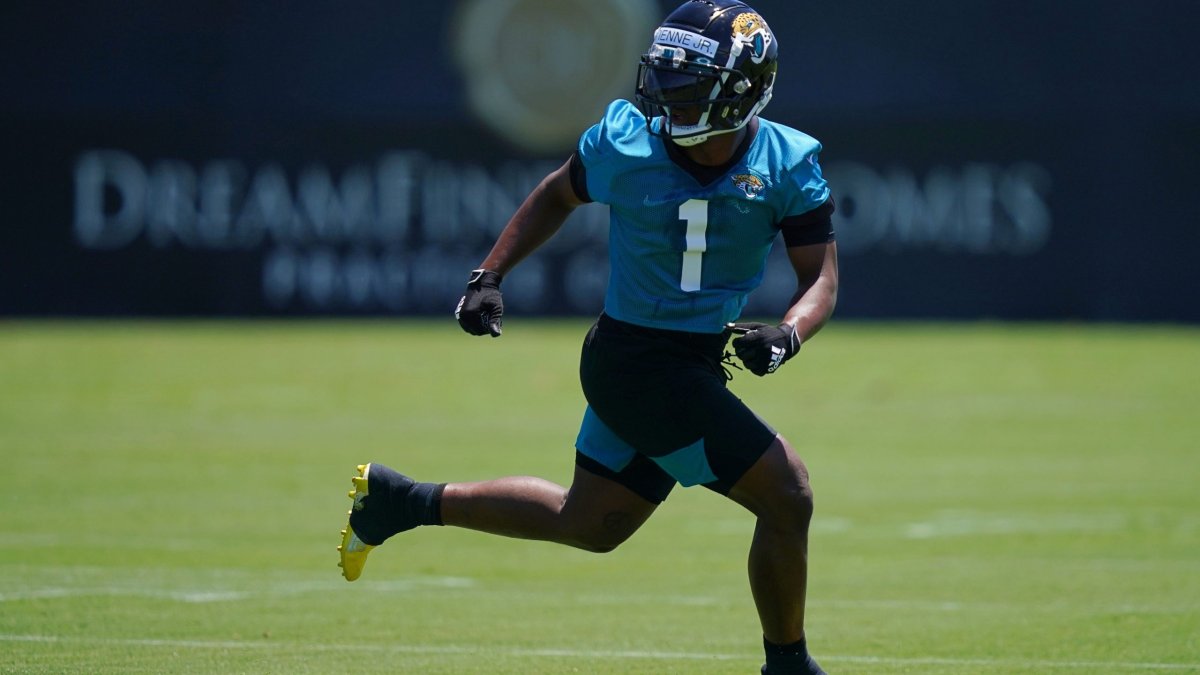A new era is here for the Jacksonville Jaguars. The team remodeled its offense from a season ago after finishing 32nd in rushing attempts, 31st in offensive scoring, 28th in explosive pass-play rate (11.6%) second in pass-play rate (69.2%) and first in total pass attempts when trailing.
Led by the No. 1 overall pick in the 2021 NFL Draft, Trevor Lawrence, the Jaguars should still favor the passing game — especially when trailing — but look for them to feature a more balanced offense than their 2020 unit.
Subscribe to
2021 Team Preview
Jacksonville should be more competitive and therefore hold more leads in 2021, which will allow the team to deploy a more consistent ground game. New offensive coordinator Darrell Bevell ranked 11th in neutral game script run-play rate in his past two seasons (2019-2020) with the Detroit Lions. But Bevell’s influence on the offense doesn’t stop there.
This passing game is going to take full advantage of Lawrence’s deep-ball prowess (PFF’s fifth-highest-graded quarterback on throws of 20-plus yards), as it did in past years with Matthew Stafford.
Under Bevell, the Lions’ passing game ranked ninth in explosive pass-play percentage, and Stafford ranked third in the NFL in average depth of target (10.7 yards).
Jacksonville's rookie quarterback was also effective on the ground in college, finishing as PFF’s fourth-highest-graded rusher in 2019, and fantasy football players can be sure that head coach Urban Meyer will leverage that ability near the goal line.
Over the past two seasons, no team has passed at a higher rate inside the five-yard line (64%) than the Jaguars. Unfortunately, their hyper reliance on the passing game has not translated into frequent scores, as they have just nine receiving touchdowns from inside the five-yard line over that span (fifth worst).
Meanwhile, when they have elected to run the football in that area of the field, their rate of achieving a first down or touchdown ranks fourth-best (57.1%).
Under a new coaching staff, Jacksonville is set to flip the script when deep in the red zone. Bevell’s Detroit offenses rushed at the 11th-highest rate from inside the five-yard line (59%), and Meyer has a track record of leveraging quarterbacks as rushing threats (J.T. Barrett, Braxton Miller, Tim Tebow). Lawrence averaged five rushing touchdowns per season from inside the 10-yard line in three seasons at Clemson.
Lawrence is the perfect late-round quarterback because of his “sneaky” rushing upside, but Jacksonville has even more fantasy juice to squeeze that goes beyond the young signal-caller.
With the third-most vacated targets (43%) and the fourth-most vacated air yards (46%), there are ample opportunities for two breakout candidates in Jacksonville who all fantasy football managers should have extremely high on their draft boards.
Breakouts
RB Travis Etienne
Rookie running back Travis Etienne should be viewed as the clear favorite to lead the team in running back snaps. First-round running backs don’t sit.
The backfield will start as a committee, but Etienne will benefit the most from receptions and goal-line work. That usage puts the rookie into low-end RB2 territory, whereas James Robinson’s ranking plummets from solid RB2 to outside the top 30.
Etienne notched the most carries inside the five-yard line among FBS running backs since 2018 and ranked first in PFF receiving grade at the position. His experience in both facets ensures that even 12-15 touches per game will be of the fantasy-friendly variety.
Don't get too wrapped up in the Robinson/Carlos Hyde running back debacle to the point where the big picture isn't clear. Etienne is attached to his college quarterback, who he connected with for over 100 receptions at Clemson. This is a great situation for him to be in.
As Meyer said, Etienne is going to be the third-down back. He’s going to be involved heavily in the passing game, and that needs to be cherished in PPR formats.
Temper expectations for Etienne to start the year, with the mindset that you’ll likely have a fringe RB1 by the time the fantasy playoffs come knocking. His explosive upside — 40 rushing attempts of 20-plus yards, 11 more than the next-closest running back from 2018 through 2019 — will be exciting to watch behind an ascending offensive line.
WR Laviska Shenault Jr.
Jacksonville Jaguars wide receiver Laviska Shenault has second-year breakout written all over him.
The rookie flashed his versatility and playmaking ability in 2020, finishing second in missed tackles forced per reception (27.6%, 16 total missed tackles) and third in total rushing attempts among wide receivers.
He was also serviceable in fantasy football down the stretch. Shenault was the WR28 from Weeks 14-17, averaging 13.5 fantasy points per game and commanding a 23% target share. His final two games demonstrated the tantalizing potential: 17.2 fantasy points per game on 11 catches for 116 yards and three touchdowns.
But perhaps the most intriguing metric when it comes to Shenault is his PFF receiving grade versus man coverage (84.6). That mark puts him into an elite tier along with Justin Jefferson, Michael Thomas, Odell Beckham Jr., Mike Evans, Terry McLaurin, A.J. Brown and Stefon Diggs, all of whom went on to become locked-and-loaded fantasy superstars.

Busts
WR D.J. Chark Jr.
Shenault is the Jaguars' wide receiver to draft in Rounds 6-7, not D.J. Chark Jr. In the games the duo played together, Shenault outproduced Chark in fantasy points per game (11.7 versus 10.8) and total receiving yards — on 11 fewer targets.
Chark’s target rate per route (19%) — also known as threat rate — was also inferior to Shenault’s last season (19.8%).
Chark is the Jaguars' perceived No. 1 receiver based on average draft position (ADP), but he actually ranked 49th in threat rate out of 50 qualifying wide receivers who saw at least 95 targets. Ironically, the 50th player was newly acquired Jaguars veteran wideout Marvin Jones Jr.
The low figures in that facet for both vertical receivers indicate neither will be a target hog in 2021, which could make their fantasy production extremely dependent on splash plays downfield.
Considering their production has been nearly identical over the past two seasons, Jones is the vastly superior value. He’s going nearly 50 spots after Chark in fantasy football drafts. Jones’ familiarity with the team’s offensive system from his time spent with Bevell should also give him a leg up early on in the season.
Marvin Jones Jr. and D.J. Chark Jr. | 2019-2020
| Player | PFF grade | Tgts | Rec. | Yds | TDs | aDOT | Yds per route run | Yds per reception |
| Marvin Jones Jr. | 77.7 | 204 | 138 | 1757 | 18 | 13.4 | 1.56 | 12.7 |
| D.J. Chark Jr. | 76.2 | 206 | 126 | 1714 | 13 | 13.3 | 1.60 | 13.6 |
It’s also pretty common to see field-stretchers like Chark get phased out in highly competitive receiving corps. That played out last year in Dallas with Michael Gallup, so it’s easy to foresee Chark falling victim to similar circumstances.
The market is too fixated on his WR18 fantasy finish from 2019 when he was more solid than elite. That season, Chark finished 22nd in PFF receiving grade (75.8) and 25th in yards per route run (1.69).
As the highest-priced Jaguars wide receiver, he will have a difficult time paying off his ADP amid his toughest competition for targets to date.
RB James Robinson
James Robinson’s stock took a hit when Jacksonville drafted Travis Etienne, and anybody holding out hope that J-Rob is still going to retain any kind of consistent fantasy value for the 2021 season will be disappointed. The new coaching staff has no attachment to him, and the volume he received last season that vaulted him to fantasy RB1 status is nothing more than a distant memory.
The real driver behind Robinson’s fantasy success — as is the case for most running backs — was sheer volume in 2020. His 96% of team running back carries in the 14 games he played was by far the most in the NFL last season. Christian McCaffrey saw a 93% share in his historic 2019 season.
Robinson’s final team running back opportunity share — combining running back carries and targets — was 73%, which ranked second to only Derrick Henry.
Needless to say, the 2020 Jaguars fed Robinson more than any other running back in the NFL. It’s hard to blame them when their depth chart was rounded out by Ryquell Armstead, Chris Thompson, Dare Ogunbowale and Devine Ozigbo.
With the running back room revamped in 2021, Robinson’s chances at returning to reliable fantasy value will be extremely low.
Not to mention, former Buckeye Carlos Hyde has also been thrown into the Jaguars’ running back rotation, and he shouldn’t be overlooked. Wherever Hyde has ended up playing the past few seasons — Seattle, Houston, Cleveland or Jacksonville — he has found a way to garner touches and opportunities.
And let’s not forget that Bevell orchestrated the Lions' backfield last season — the same offense that operated a committee involving Adrian Peterson, Kerryon Johnson and D’Andre Swift despite the rookie outplaying the others.
There’s a multitude of different ways this backfield could shake out this season, but the writing’s on the wall that Robinson might be the one left wondering where everything went wrong.
With virtually the same ADP as future fantasy superstar Laviska Shenault Jr., Robinson is still not worth his draft price.
Sleepers
WR Collin Johnson
Searching for the NFL’s next red-zone weapon? Look no further than 2020 fifth-rounder and 6-foot-6 monster Collin Johnson. The big-bodied Jacksonville Jaguars wide receiver finished ninth last year among wide receivers in target rate per route run inside the 10-yard line (39%) and led the team in yards per route run (1.60).
With zero tight ends of relevance to speak of, Johnson could carve out a role as the team’s primary red-zone option, which would lead to several spike weeks of fantasy production.
Still, don’t necessarily pigeonhole Johnson as a red zone-only threat. He is deceptively fast when running downfield and could easily take on a role as a “big slot” on the inside of the formation.
In the two games he played last season with a 50%-plus snap share, Johnson led the team in 20-plus-yard targets.
Urban Meyer doesn't think DJ Chark can play BIG
6-foot-6 second-year WR Collin Johnson plays BIG#BIGpic.twitter.com/rc4qUQU7AF
— Andrew Erickson™ (@AndrewErickson_) June 7, 2021
Meyer has already chirped about Chark’s lack of “playing big,” so if the fourth-year receiver falters, the head coach could turn to Johnson as a one-for-one replacement. He’s not afraid to take full advantage of his size.



 © 2025 PFF - all rights reserved.
© 2025 PFF - all rights reserved.